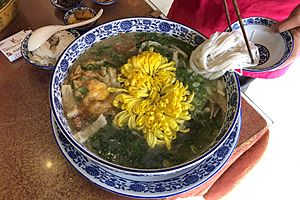Crossing-the-bridge noodles facts for kids
Quick facts for kids Crossing-the-bridge noodles |
|
|---|---|
 |
|
| Traditional Chinese | 過橋米線 |
| Simplified Chinese | 过桥米线 |
| Literal meaning | Cross bridge rice noodles |
| Hanyu Pinyin | guòqiáo mĭxiàn |
| Yale Romanization | gwo kìuh máih sin |
| Jyutping | gwo3 kiu4 mai5 sin3 |
Crossing-the-bridge noodles is a famous rice noodle soup from the Yunnan province in China. It's one of the most well-known dishes in Yunnan cuisine, loved for its unique way of serving.
Contents
What Are Crossing-the-Bridge Noodles?
This special noodle dish has been around for over 100 years! In 2008, it was even named an important cultural heritage of Kunming city. This helped share Yunnan's amazing food with more people.
The dish comes with a big bowl of very hot soup. This soup is usually made from chicken and pork bones. It's seasoned with things like ginger and star anise. A layer of chicken fat floats on top. This fat acts like a blanket, keeping the soup super warm for a long time.
You get the soup and all the other ingredients separately. These ingredients come on a plate or cutting board. They include fresh vegetables and thinly sliced meats. Some common ingredients are thin slices of turkey, pieces of chicken, chicken skin, and chives. You also get sprouts, bean curd sheets, and of course, rice noodles.
When you're ready to eat, you add these raw ingredients into the hot soup. They cook very quickly in the boiling broth. The chicken fat melts, making the soup shiny and delicious. After a few minutes, the noodles and other ingredients are cooked. Then, you can spoon the soup into smaller bowls to enjoy!
Why Is It Called "Crossing the Bridge"?
There's a popular story about how this dish got its name. Long ago, a smart student was studying very hard for his imperial exams. He lived on a small island, and his wife would bring him food every day.
But by the time she crossed the bridge to the island, the soup would be cold. The noodles would also get soggy. So, she came up with a clever idea! She put boiling hot broth in a large clay pot. She added a layer of oil on top to keep the broth warm.
She carried the noodles and other ingredients in a separate container. When she arrived, she mixed everything together. This way, her husband could always enjoy a warm, fresh bowl of soup!
Another idea for the name comes from how you eat the dish. You "cross" the ingredients from their separate plates into the hot soup bowl. It's like they are crossing a bridge! There are many other fun stories about the name's origin too.
Different Kinds of Noodles
The main part of these noodles is rice. How the rice vermicelli is made can be different in various places. In Kunming and other parts of Yunnan, there are two main types:
- "Sour paste" noodles: As the name suggests, these noodles have a slightly sour taste. They are usually thicker and softer.
- "Dry paste" noodles: These don't have the sour taste. The noodles are thinner and a bit firmer.
Some older people in Kunming think the "sour paste" noodles are the most traditional. Many people in Yunnan believe that noodles from Mengzi County and Jianshui County taste even better than those from Kunming.
Today, there are many new kinds of noodles to choose from. People now often like "water-washed rice noodles" because they are smooth and easy to eat. You can also find "purple rice noodles," which are made by mixing in purple rice.
How People Enjoy Them Today
Crossing-the-bridge noodles have changed how people eat, especially for breakfast. In many street markets, you can get a quick bowl. Hot, fresh rice noodles are put into boiling water for just half a minute. Then, a flavorful sauce is added on top. This sauce is sometimes called the "hat" of the noodles. In the morning markets, a bowl of crossing-the-bridge noodles can be ready in about one minute!
There are also special restaurants that serve more fancy versions of this dish. They might have more ingredients or a more elaborate way of serving them.
What's in the Dish?
When you order guoqiao mixian, you usually get:
- Raw quail eggs
- Thin slices of ham
- Slices of chicken
- Colorful vegetables
When your dish arrives, you first get a bowl of super hot soup. Then, the server will often help you add the ingredients. They usually put the raw meats in first, then the quail eggs, and finally the vegetables. After that, they use chopsticks to "cross" the noodles into the bowl. Once everything is mixed, your delicious meal is ready! You can add more oil, chili, vinegar, or soy sauce to your liking.
Images for kids




